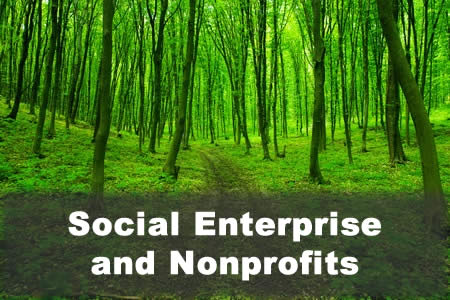Social enterprise, or businesses that strive to make profits with the social good in mind, is growing from an increasing customer awareness of global inter-connectivity that directly affects purchasing decisions. A 2014 Nielson report shows that 55 percent of global customers across 60 countries are willing to pay more for products that have positive social and environmental impact. (See report here.)
Trends of young talent wanting to do social good (more than 70 percent globally according to Entrepreneur.com) are also leading to businesses turning to social enterprise models to attract and retain high level employees.
As a result of the burgeoning world of businesses that strive toward public good, the lines are blurring more and more between charities and businesses.
The difference between social enterprise and nonprofits
In short, social enterprises want to make profits while also maximizing positive social impact (can be for-profit or non-profit); and nonprofits use their surplus income to achieve their mission rather than distributing it as profit.
Social enterprises look for means to help society through making money. An example is Ten Thousand Villages, which sells artisan products from all corners of the globe at fair trade prices to help the sellers and their communities, but with the goal of making a profit for company owners. They are using the social good in a way to attract buyers and sell their products, to create a win-win situation for profits and social good.
National Geographic, on the other hand, is a charity that sells fair trade artisan products that uses a portion of the profits to support its charitable work and mission. (The National Geographic Society is one of the largest nonprofit scientific and educational institutions in the world.)
Nonprofits turning to revenue making models
Many nonprofits are using some sort of “earned income”, or revenue-making scheme like National Geographic’s artisan sales to raise at least part of their program revenue and operating support. The trend moves nonprofits toward self-sufficiency by depending less and less on donations and also promoting entrepreneurship and marketplaces within the community.
A Forbes article on the Top 10 Reasons for Non-profits to Move to Revenue Driven Model, some of the key reasons for the shift, beyond the obvious sustainability feature of not having to fundraise, are that:
- Revenue making models give nonprofits more flexibility to adapt to change;
- Organizations can hire better employees and train their employees better; and
- Organizations can have exponential impact by paying forward their revenues toward their mission with more projects and programs.
Direct product sales as a revenue making model
Nonprofits can directly sell products and services to make a profit directly related to their mission: National Geographic is selling artisan products because it supports communities within developing nations and it also supports its mission to “inspire people to care about the planet”.
Girl Scouts sell cookies because it teaches the girls responsibility, independence, and sustainability, along with business skills. This is the most basic sales model for a nonprofit that can help them meet a percentage of operating or project funding needs.
Establishing affiliated social enterprises within the nonprofit
A number of organizations set up sister corporations that funnel their profits into charitable arms. They are social enterprises that dedicate a set portion of profits directly to a charitable mission. Homeboy Industries in California has a mission to help previously incarcerated or gang involved residents, especially youth. They sustain up to half of their organizational funding from social enterprises that have little to nothing to do with ex-cons.
Along with gourmet cafes at farmers markets, they ship cakes and pies across the country. The business model of the social enterprise focuses on advertising the social cause to some degree, but also on the taste and value of the food itself. Their advertisement rings, “Giving back never tasted so good.” Clients are attracted to purchasing because they like to support the cause, but also because they are in the market to purchase food.
Is revenue generation right for your nonprofit?
Revenue generating schemes and other linkages with social enterprise and its tactics have obvious benefits, but are they right for your organization and subsequently worthy of the time and resources necessary to develop them?
Consider the following resources to help you decide:
- Society for Nonprofits offers a quick pros and cons list for nonprofits thinking about applying earned income/sales strategies, and also quick steps on how to get started if you do choose to go forward.
- The Canvas Kit is based on Business Model You and helps nonprofits visualize, in just a few hours, where they might build on sales and fundraising strengths to increase revenue.
- A study of more than 140 nonprofits published in Stanford Social Innovation Review (2009) lays out 10 Nonprofit Funding Models that work for exponential growth based on an organization’s mission, strengths, and weaknesses. The article offers simple questions for nonprofit leaders to ask about their organizations to pick the most effective fundraising model – some of which require earned income plans and some that don’t.
- If you are not sure whether or not social enterprise is right for your organization, try something small, like a simple product sale or renting out your facilities for weddings or meetings, and evaluate the effort put into making your revenue vs. the profits themselves. Also gauge how much the project is distracting from your actual mission to do good in the community.
In the end, the key to being a successful nonprofit is to stay true to your mission to improve your community, and only pursue business strategies if they help you toward that end or save you enough time to make it worth your while!

